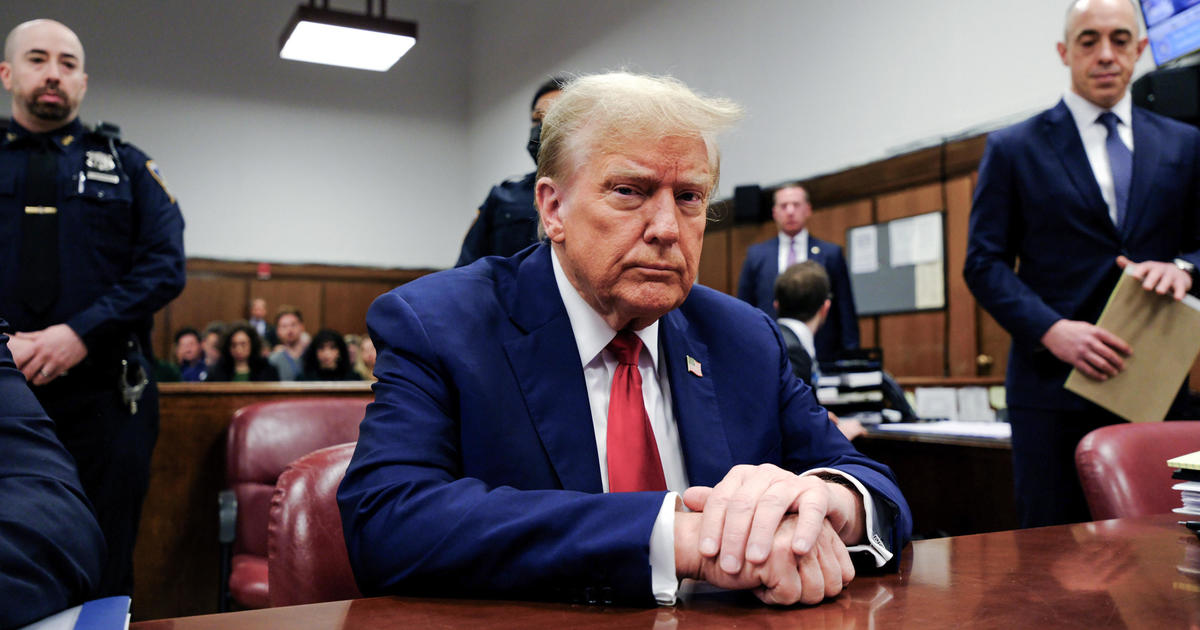Trump Announces Plan To Re-Examine Fuel Economy Standards
YPSILANTI (WWJ/AP) - President Donald Trump plans to re-examine federal fuel economy requirements for new cars and trucks.
The announcement was made Wednesday during a speech before UAW member gathered in a repurposed airplane hangar at the American Center for Mobility in Ypsilanti, west of Detroit.
"The era for the economic surrender for the United States is over, it's over," Trump told the crowd at the crowd at the site, which produced B-24 bombers during World War II and is being converted into an automotive testing and product development facility.
"My administration will work tirelessly to eliminate the industry-killing regulations, to lower the job-crushing taxes and to ensure a level playing field for all American companies and workers," Trump explained.
He said fewer regulations will mean more jobs in the auto industry, adding there will be "consequences" for American companies that ship jobs elsewhere.
"...The assault on the American auto industry is over, believe me, it's over," the president said.
The fuel economy requirements Trump referenced were a centerpiece of President Barack Obama's strategy to combat global warming. But Trump appears to be making good on a pledge to car company CEOs to reduce what he sees as impediments to good business.
Here's a breakdown:
___
WHAT ARE CAFE AND GHG STANDARDS?
CAFE (Corporate Average Fuel Economy) standards are mile-per-gallon targets for cars and trucks set by the U.S. government. The standards are based on size and are weighted by sales. Each manufacturer has a different requirement based on the models it sells.
Congress required the National Highway Traffic Safety Administration to develop CAFE standards in 1975 after gasoline shortages during the Arab oil embargo. The U.S. Environmental Protection Agency began regulating greenhouse gas emissions from vehicles in 2007. The agencies work together to produce CAFE standards.
The standard for passenger cars stayed at 27.5 mpg from 1990 until 2007. In 2009, the government set a fuel economy standard of 34.1 mpg for cars and light trucks by 2016. In 2012, it set a new target of 54.5 mpg by 2025. The number can change depending on the mix of vehicles customers buy. Right now, it stands at 51.4 mpg because people are buying more SUVs and trucks.
___
UNDER THE CURRENT STANDARD, WOULD MY CAR GET 54.5 MPG IN 2025?
No. Manufacturers can apply credits for various fuel-saving technologies to arrive at that figure. Real-world mileage would be closer to 36 mpg.
___
WHAT'S HAPPENING NOW?
In the last days of the Obama administration, the EPA completed a review of the standards for model years 2022-2025 and left them unchanged, saying the car companies have many affordable options to help them comply. The industry protested, saying the review was too hasty and didn't consider the fact that gas prices have fallen and few consumers want the smallest, most fuel-efficient vehicles.
President Trump is reopening the evaluation process, which could lead to weaker standards.
___
WHY WOULD THE GOVERNMENT CONSIDER CHANGING THE STANDARDS?
President Trump wants automakers to expand production in the U.S. and hire more workers. In exchange, he has promised to cut regulations and taxes. Gasoline is more than $1 per gallon cheaper than it was in 2012, when the standards were issued. The low prices hurt demand for more fuel-efficient cars. If those cars don't sell, their high mileage can't be counted toward an automaker's corporate average fuel economy.
But environmental groups say weakening the standards would increase pollution and require consumers to spend more on gas.
___
HOW ARE AUTOMAKERS IMPROVING THEIR FUEL ECONOMY?
Manufacturers have introduced all-electric cars like the Chevrolet Bolt and increased the use of lightweight materials like aluminum. Engine technologies, such as direct fuel injection, and more efficient transmissions are also contributing. The standards give manufacturers extra credit for new technologies, such as hybrid engines for pickup trucks and stop-start systems, which automatically shut off the engine when the vehicle stops in traffic.
___
DO THOSE ADDED TECHNOLOGIES MAKE MY VEHICLE MORE EXPENSIVE?
Yes. In its final ruling in January, the EPA estimated the fuel economy standards will cost $875 per vehicle. A study commissioned by the Alliance of Automobile Manufacturers estimates the cost of compliance at $1,249 per vehicle. However, the EPA says the standards would save consumers up to $1,620 in gas over the life of their vehicle.
___
IF THE STANDARDS ARE WEAKENED, WILL THAT AFFECT WHAT KINDS OF CARS ARE AVAILABLE?
Maybe. Automakers might choose to offer fewer electric or hybrid cars in the U.S., since those are less profitable than trucks and SUVs. They also could scrap subcompact cars, which are unpopular with U.S. consumers but help meet fuel economy targets.
There are caveats. Automakers will still have to meet rising fuel economy standards in China and Europe, so they won't stop making efficient vehicles. If gas prices rise, U.S. consumers might demand more fuel-efficient cars. Finally, California and other blue states have a history of passing stricter standards than the rest of the country. If that continues, automakers would have to keep their most fuel-efficient models in U.S. showrooms, since California is the biggest market in the U.S.
Also Wednesday, Trump teased another "big" upcoming announcement regarding automakers, but offered no details.
[MORE: Anti-Trump Protester Detained By Police Amid Scuffle Outside President's Speech; Autoworkers Get Time Off To Attend, Others Protest Trump Speech]
© Copyright 2017 CBS Broadcasting Inc. All Rights Reserved. The Associated Press contributed to this report.



